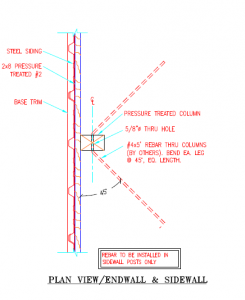Importance of Constrained Posts
In structural design of post frame (pole) buildings, an ability to transfer wind shear loads from roof to endwalls to ground becomes a key to cost effective design success. When sidewall columns are in a properly constrained condition (usually by attachment to a concrete slab-on-grade) shear forces are reduced by 25%. This reduction can result in smaller dimension sidewall columns, as well as a reduction or elimination of need for OSB (Oriented Strand Board) or plywood reinforced roof or endwall planes.
These savings are most often apparent in buildings with a far greater length than width, are fairly tall (especially if narrow) and/or are in high wind regions. In some cases savings from constraining sidewall columns can overcome a significant amount of costs to pour a slab-on-grade!
Savings – I now have your attention. Now I will explain constrained.
Excerpted from National Frame Building Association Post-Frame Building Design Manual (January 2015):
“5.2.4 Foundation Constraint
If a post or pier foundation is not restrained from moving horizontally at or just above the ground surface it is said to be non-constrained. Conversely, if a post or pier foundation pushes against (or is attached to) an “immovable” structural element such that the lateral displacement at some point at or just above the ground surface is essentially equal to zero, the foundation is said to be constrained. An example of a constrained post or pier foundation is one that bears against a concrete slab-on-grade.
 A single post can be both constrained or non-constrained, depending on the load case. Using the previous example of a concrete slab-on-grade, and assuming that the post is not attached to the slab, if the wind loading was such that the post was pushing on the slab, the post would be considered constrained. However, if the wind were blowing in the opposite direction, the post would not be supported by the slab; hence, the post would be analyzed for that load case as non-constrained.”
A single post can be both constrained or non-constrained, depending on the load case. Using the previous example of a concrete slab-on-grade, and assuming that the post is not attached to the slab, if the wind loading was such that the post was pushing on the slab, the post would be considered constrained. However, if the wind were blowing in the opposite direction, the post would not be supported by the slab; hence, the post would be analyzed for that load case as non-constrained.”
In simple terms, attach sidewall columns to a concrete slab-on-grade to prevent ground surface movement. Rebar hairpins can be an effective method to achieve a constrained condition, and can be read more about here: https://www.hansenpolebuildings.com/2016/10/rebar-hairpins/.






